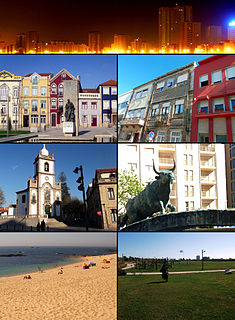
There are several religious or popular celebrations, pilgrimages (romarias) and processions (procissão) in Póvoa de Varzim, Portugal. Most of these festivals occur around the Holy week or during the summer.

Póvoa de Varzim, in Portugal is an ethno-cultural entity stemming from its working classes and with influences arriving from the maritime route from the Baltic Sea to the Mediterranean. The most charismatic of its communities, formerly overwhelmingly dominant, is the fisher community. It has significant similarities with those of the Danish fjords and it is one of Portugal's oldest ports. Póvoa de Varzim has distinct cultural traits and a strong local identity.

A Ver-o-Mar, Aver-o-Mar or Averomar is an urban area in Póvoa de Varzim. It is a former civil parish currently located in União das Freguesias de Aver-o-Mar, Amorim e Terroso, of which it is its seat. In the census of 2001, it had a population of 8,675 inhabitants and a total area of 5.21 km². A 2012 law merged the parish with neighbouring Amorim and Terroso, becoming the northern parish of the city of Póvoa de Varzim.
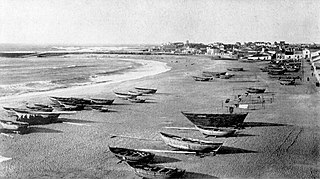
Póvoa de Varzim is a former Portuguese civil parish, located in the city of Póvoa de Varzim. It is the core of the city of Póvoa de Varzim and until the new city limits established in 1995 it was the single parish that made up the city. In the census of 2011, it had a population of 28,420 inhabitants and a total area of 5.25 km². A 2012 law merged the parish with neighbouring Argivai and Beiriz, becoming the southern parish of the city of Póvoa de Varzim, known as União das Freguesias da Póvoa de Varzim, Beiriz e Argivai.

Bairro Sul, literally the South Neighborhood, also known as Lapa, is the fishery district of the city of Póvoa de Varzim in Portugal. It is one of the six traditional neighborhoods of Póvoa de Varzim and one of the eleven parts in which the city is subdivided. The quarter is situated south of Póvoa de Varzim City Center. It has green and white as neighborhood colors and Lancha Poveira as symbol, also the icon of the city.

Giesteira or Bairro de Belém is a neighbourhood of the Portuguese city of Póvoa de Varzim. It is one of the six traditional neighbourhoods of the city, and one of the eleven city districts. Giesteira is located northeast of the Póvoa de Varzim City Center and subdivided by the parishes of Póvoa de Varzim Parish and Beiriz, most of its land area belongs to Beiriz civil parish.
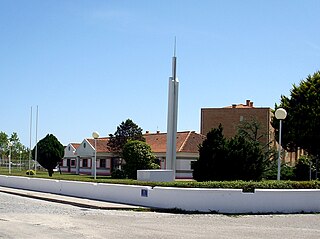
Gândara is a neighbourhood of the Portuguese city of Póvoa de Varzim.
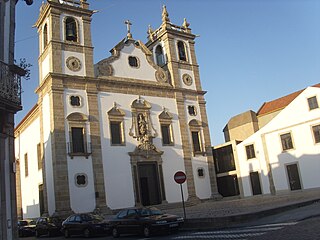
Bairro da Matriz is the historical neighbourhood of the Portuguese city of Póvoa de Varzim and part of the Matriz/Mariadeira district.
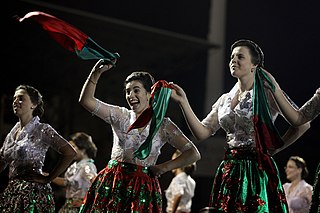
The urban area of Póvoa de Varzim in northern Portugal is divided into eleven districts, each with distinctive zones (zonas), which are significant areas of the city and have population and topological differences. The vernacular terminology and 19th century subdivisions for the town is Bairro.
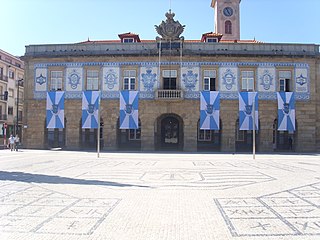
Póvoa de Varzim City Center or Downtown Póvoa de Varzim is the heart of Póvoa de Varzim in Portugal, and is the location for most of the city's municipal services, tourist attractions and businesses. It is the center, not only for the city or the municipality, but also neighboring municipalities. The greater downtown area also called "Centro" can also include most districts part of Póvoa de Varzim Parish.
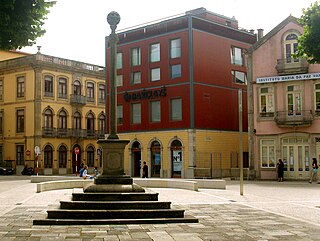
Praça do Almada is the civic center of the city of Póvoa de Varzim in Portugal, and is located in Póvoa de Varzim City Center. It contains the sculpture that pays homage to Eça de Queiroz, a notable writer who was born there.

Avenida dos Banhos, is the main waterfront street and a popular tourist attraction in Póvoa de Varzim, Portugal. It roughly encompasses the central waterfront area of Póvoa de Varzim from Passeio Alegre Square and the Port of Póvoa de Varzim to Vasco da Gama Avenue.

The Garrett Theatre is a theatre located at Rua José Malgueira Street in Junqueira quarter, Póvoa de Varzim, Portugal which is often referred simply as Garrett. It is one of the historic theatres of Portugal, and some of the best performers of Portuguese, Brazilian and Spanish drama staged there, including Ary Fontoura, João Villaret, Laura Alves, Procópio Ferreira, and Ruy de Carvalho. Orchestras, tunas, variety shows, political meetings were also common in Garrett history.

The Port of Póvoa de Varzim is a seaport built in Enseada da Póvoa Bay in the city of Póvoa de Varzim in Portugal. During the Middle Ages, it was known as Port of Varzim.
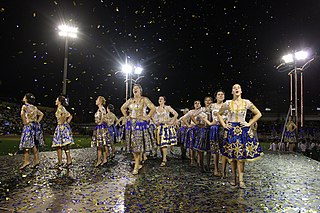
Tricana poveira is a traditional style of women's clothing from the Portuguese city of Póvoa de Varzim. This look, consisting of colorful costumes, was fashionable and mainstream from the 1920s to the 1960s. Women who dressed in the Tricana poveira style became known as tricana girls.

The architecture of Póvoa de Varzim, in Portugal, demonstrates a broad variety of architectural styles over its thousand years of history. 11th-century Romanesque, 16th-century Mannerism, 18th-century Baroque, late 18th-century neoclassicism, early 20th-century Portuguese modernism and late 20th- to early 21st-century contemporary architectural styles and more are all represented in Póvoa de Varzim. As a whole it represents a rich eclectic tradition and innovation shaped by the people, their beliefs and economy.

Póvoa de Varzim Holiday, Saint Peter Festivals or Saint Peter Night is celebrated annually on June 29, Saint Peter's Day in Póvoa de Varzim, Portugal. It is a late midsummer festival and the last of the three Portuguese popular saints — Santos Populares. It is celebrated with the lighting of bonfires, dances, competitions between quarters and diverse parties. Saint Peter festival includes the "rusgas", in which inhabitants of one quarter (bairro) visit in a parade other quarters in the evening of June 28. Women are dressed as tricana poveira. Each neighborhood has its own festival, neighborhood colors and altar to Saint Peter.

Avenida Vasco da Gama is a street in the north central area of Póvoa de Varzim, Portugal. It is one of the main avenues in the city, with hotels, banks, sports areas, bars and is the location in the city with most high-rises. It runs from Avenida do Mar, expansion of the avenue to A28 Motorway (freeway), and Rua Gomes de Amorim to Avenida dos Banhos in the waterfront. It has some of Póvoa de Varzim's most famous landmarks such as Touro and Póvoa de Varzim Bullring.




